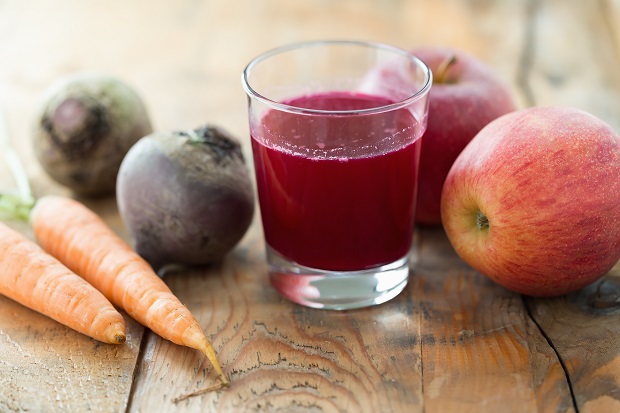Exploring Health Benefits Of Juicing With Dietitian Leah Bosley
Nov 15, 2015
For those of you looking to live a little healthier, there’s good news: healthy living is very popular these days. But with that popularity, there are a lot of “healthy” fads that come and go—and sometimes it’s hard to know what’s really worth your time and attention. We wanted to take a look at one of today’s most popular trends, so we asked our own Clinical Nutrition Manager to weigh in on some of the benefits, myths and caveats of juicing. Presenting “The Juicy Facts” with Leah Bosley, MA, RD, LD.
What are some of the health benefits of juicing? How is it different than just eating fresh fruits and vegetables?
Since most people have a hard time incorporating enough fruits and vegetables into their everyday diet, juicing is an easy way to get in those important foods. Some people can eat more vegetables daily by “hiding” the taste with sweeter fruits in their juice.
How is juicing different from making smoothies?
Juicing requires its own equipment—specifically, a juicer. Since juicers can be expensive, another great suggestion is to use a blender and make smoothies. Smoothies do not take away the fiber of the fruits and vegetables, so all the contents are blended together. You can make a “smoother” drink since smoothies are usually made with some sort of liquid to help blend and hide the roughness of the fibers.
Speaking of fiber, people often talk about “losing the fiber” from the fruits and veggies when juicing. Don’t we need fiber?
Yes, we need fiber—and yes, when you juice, you lose the fiber that’s in whole fruits and vegetables. Juicing machines extract the juice and leave behind the pulp, which is where the fiber is found. To get the health benefits of that fiber, it’s often suggested that you add some of the pulp back into the juice, or use the pulp in cooking (e.g., soups, broths for cooking rice or pasta, muffin batter). My recommendation is to add at least half the pulp back into the juice before you drink it.
Juicing is great, but you should also still try to get whole fruits and vegetables in your diet to increase fiber intake. Aim to eat two whole fruits and three vegetables a day; and think about getting a variety of colors in your fruit and vegetable diet to get a broader range of nutrients.
Can juicing really help you lose weight?
Ultimately, it’s always best to incorporate juicing into a balanced diet. You can make your juice more balanced by adding protein from almond milk, yogurt, flaxseed, peanut butter or protein powder. During a juice-only diet, you may not get enough protein and fiber to help you feel full and satisfied, so you may end up drinking more calories than you would if you were eating wholesome foods and adding just one serving of juice to your day. Juicing-only diets can just become too extreme. People claim it “detoxes” your body. In reality, there is no research that confirms this. Your liver and kidneys can detox on their own with a balanced, healthy diet.
What about juicing for a healthy pregnancy?
Our bodies always benefit from a diet rich in fresh fruits and vegetables, whether they’re juiced or not. Fresh juice made at home is more concentrated, and has the best percent of natural nutrients versus a commercial juice that can have lots of added sugars and preservatives. Juice should never really replace a meal, but it can aid in obtaining your fruit and vegetable servings. Never go on a juice fast while you are pregnant. It’s okay to incorporate smoothies and juice into your daily diet; just remember to consume a healthy diet as well.
What about juices for working out/physical activity? (Both for beforehand and afterwards?)
Complex carbs and a good protein source are better suggestions for pre- and post-workout. Try a protein shake or a smoothie with a protein source in it during a strenuous exercise.
What about juices after a night out and having a little too much fun?
Make a glass of carrot, apples, cauliflower, and broccoli juice to relieve the hangover headache.
Any advice for people getting into juicing, or considering juicing?
Some tips to consider for ingredients: Carrots, green apples, and green vegetables help to cleanse the digestive system by removing toxins through elimination. Spinach is highly cleansing and is essential for the body’s circulatory system and the brain. Beetroot juice and grapefruit cleanses the liver and helps detox alcoholic toxicity.
Celery is a great source of calcium and magnesium that can have a calming effect on the central nervous system. Cauliflower and broccoli contain calcium and magnesium as well, and can help prevent and relieve headaches. Cantaloupe and watermelon juices are diuretic; they are helpful for flushing out the toxicity from your body via the kidneys.
Some more general advice:
Be creative with fruits and vegetables. The sweetness in your juice will come from the fruits, so always add more fruit for natural sweeteners to vegetable juices/smoothies. Remember that juices are a concentrated beverage and calories can add up fast. Four ounces of juice = One Carbohydrate exchange. So for diabetics, be aware of what fruits you are adding into your juicing.
To stay fuller longer or to use a juice as a snack or occasional meal replacement, add a protein source or replace half of the pulp back into the juice, so you are getting the necessary fiber needed to stay fuller longer.
To juice or not to juice? Would you rather drink your vegetables, or eat them? Have any good juicing tips you want to share? Talk to us on Facebook and tell us what you think!
